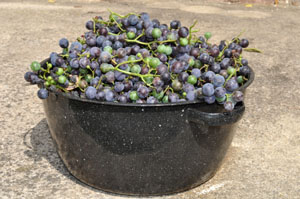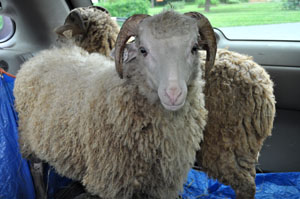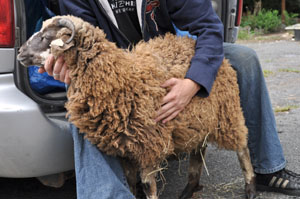Posted by · Leave a Comment
Our host, Tracy Toth, completes our tour of a riparian buffer while demonstrating how native plant species can support a healthy ecosystem.
Posted by · Leave a Comment
Our host, Tracy Toth, completes our tour of a riparian buffer while demonstrating how native plant species can support a healthy ecosystem.
Posted by · Leave a Comment
 I’ll tell you: make one and a half quarts of grape juice and two batches of grape jelly, that’s what.
I’ll tell you: make one and a half quarts of grape juice and two batches of grape jelly, that’s what.
I don’t know what kept me from making jelly years ago. When I first started canning, I was drawn toward the jams because it was just a matter of squishing everything up and adding sugar and pectin. I was so proud! But, then, came the turned-up noses of two toddlers to the texture of the fruit and jelly—who knew? The following year, I relented and began making jelly. WHAT A SNAP?! Why was I intimidated? What was I thinking?
started canning, I was drawn toward the jams because it was just a matter of squishing everything up and adding sugar and pectin. I was so proud! But, then, came the turned-up noses of two toddlers to the texture of the fruit and jelly—who knew? The following year, I relented and began making jelly. WHAT A SNAP?! Why was I intimidated? What was I thinking?
 Jelly is now my preferred route of fruit preservation. I usually drip the mashed fruit overnight to collect the juice and then make the jelly, first-thing, the next morning. However, it seemed the grapes were pouring their juice through the jelly bag yesterday so I was able to make it the same day… make two batches… and collect more than a quart of juice.
Jelly is now my preferred route of fruit preservation. I usually drip the mashed fruit overnight to collect the juice and then make the jelly, first-thing, the next morning. However, it seemed the grapes were pouring their juice through the jelly bag yesterday so I was able to make it the same day… make two batches… and collect more than a quart of juice.
And there are four times as many grapes left on the vines!
Posted by · Leave a Comment


The third summer we were here I noticed cars slowing and occasionally stopping on the road nearer the pasture. I thought, for the longest time, they were looking at our animals.



One day, while I was out back noticing the tremendous number of butterflies, it dawned on me. The cars were slowing to take in the activity on the wildflowers—all the pollinators that had found their way to the native species we had let “come back.”
I hope this webisode, in particular, serves as a simple lesson in conservation: that something so easy as letting native species propagate a waterway buffer can naturally accomplish so many vital “tasks” that are necessary for a healthy ecosystem. That, and you get to enjoy one heck of a butterfly show!
Posted by · 1 Comment
Our host, Tracy Toth, demonstrates how providing an opportunity for native plant species to propagate a waterway buffer can naturally accomplish so many vital “tasks” that are necessary for a healthy ecosystem.
Posted by · 1 Comment
This week was special for us; we hosted a “ram swap”!
Our dear friend, Linda Cummings (http://guitner.blogspot.com/) from whom we purchased our first Navajo-Churro ewe and ewe-lambs came to our place to meet Shelly Gaines, a breeder from New York. They were to exchange ram-lambs (these li’l guys were born this past Spring). The swap occurred at our place—sort of a halfway point.
Now, these gals are pretty savvy when it comes to the breed. I sure learned a lot from them, such as: “clean” legs, face and belly are desirable (not “wooly”). And as much as we all love the four horns the Churro can possess, ready yourself for some bloody heads when they, inevitably, square off. Of course, the fleeces are truly important too; many breeders are picky…and rightfully so. When it comes time to market your wool, spinners seek out the best. It pays to begin to concern yourself with many of these traits at breeding time.
After the necessary paperwork was exchanged,  “Ottawa”, the stunning white ram-lamb went home with Shelly to New York and handsome little “Newman” made the trek back to Linda’s Shepherd’s Loft in Pennsylvania.
“Ottawa”, the stunning white ram-lamb went home with Shelly to New York and handsome little “Newman” made the trek back to Linda’s Shepherd’s Loft in Pennsylvania.
We’ll have to keep those guys in mind for the future (wink)…
Posted by · 1 Comment
 It’s not “just another butterfly.” It’s an Anglewing — so dubbed because of the angled and ragged edges of the wings.
It’s not “just another butterfly.” It’s an Anglewing — so dubbed because of the angled and ragged edges of the wings.
I might have passed it by if it hadn’t been for my husband, David. He told me it was fluttering about on the porch. I grabbed my camera and my son and we went out to see if we could spot it.
Nathaniel was the first to see it on the stone wall of the house. I could not make it out; it was so camouflaged! It was easy to spot after it took off because of the vibrant orange paint of the wings — but also hard to capture with the lens because it was so quick!  I managed to snap 30 pictures of this single Anglewing in the following 10 minutes. I’m posting three to show the varied appearances this one, specific butterfly is capable of. Remember: the three pictures are the same butterfly!
I managed to snap 30 pictures of this single Anglewing in the following 10 minutes. I’m posting three to show the varied appearances this one, specific butterfly is capable of. Remember: the three pictures are the same butterfly!
The Anglewing is a woodland butterfly–hardly ever visits flowers. It feasts, instead, on elms and willows as a caterpillar then tree sap, rotting fruit and other decaying matter as an adult.
One of our books suggests planting currants to attract Anglewings (done!) — since some species enjoy currants as caterpillars.
Anglewings enjoy salts from roadways and are one of the very few species of butterfly that can actually overwinter as adults. And to think, I almost never saw it.
Posted by · 1 Comment
 From year to year we have “volunteer” plants come up. They surprise us both with their locale (maybe an errant seed dropped by a bird) and species that it appears has wintered over.
From year to year we have “volunteer” plants come up. They surprise us both with their locale (maybe an errant seed dropped by a bird) and species that it appears has wintered over.
This year, among the volunteer crop, was this particular Superior potato plant.  The potatoes in the basket would be a somewhat “normal” yield for a plant but what makes this extraordinary is the fact that the whopper that Natalie is holding was also produced by the same plant!
The potatoes in the basket would be a somewhat “normal” yield for a plant but what makes this extraordinary is the fact that the whopper that Natalie is holding was also produced by the same plant!
Other volunteer seeds have produced sunflowers, tomatoes, various annual flowers, and a variety of squash/pumpkin/gourds. They’re always a treat to find in the garden because they’ll be slightly ahead in growth of what you’ve planted by seed that year.
When we first moved in, I had David rip up a large area at the back of the house for my flower beds. This year will mark the first year we did not have a volunteer tomato crop magically appearing there, in and amongst the flowers. He tended to think it could’ve been the site of an outhouse (sorry for those who can’t “stomach” the thought of life before plumbing). The more I think about it, he’s probably right.
As far as the gigantic potato-bearing plant goes? A chunk of potato was, inadvertently, left in the ground from last year and just sprouted. And, boy, did it sprout?!
Posted by · Leave a Comment
Our host, Tracy Toth, completes the tour of a wool processing “fiber mill” in Wool Webisode 3.
Posted by · Leave a Comment
I find getting a batch of wine started is one of the most difficult things to do each summer. Not because of the “how” but because of the “when.” You want perfectly ripe fruit with which to begin—yet there are so many other things that require attention because they’re “perfectly ripe” also!
This year, I was able to set aside an afternoon to get a 5-gallon bucket started. We’ve tried many types (apple, grape, meads, peach); the cherry always does well so I was happy this was to be our choice.
I began by inspecting the cherries and measuring 24 pounds. Following a simple fruit wine recipe I found online, I then mashed the cherries by stepping into a garbage bag in the food-grade bucket full of fruit and doing my best Lucille Ball impression!
Yeast was added the next day and allowed to ferment in this primary stage. After gentle daily stirrings, 5 days later, we carefully siphoned off the liquid  from the “must.”
from the “must.”

"Must" is juice that contains seeds, skins and stalks.
The liquid will sit in a glass carboy for 30 days before being again “racked” (or siphoned off) in another, clean carboy with a fermentation lock in place. Fermentation locks allow little, if any outside air to penetrate, gas to escape, and keeps unwanted fruit gnats OUT (the bacteria from one gnat can ruin the entire batch).
Notice the bubbles at the top of the glass carboy? That’s the yeast, going to town, converting the sugar into alcohol.  After I took the photo of the yeast bubbles, we added handfuls of marbles to bring the liquid up into neck of the carboy (you want as little interaction between liquid and air as possible).
After I took the photo of the yeast bubbles, we added handfuls of marbles to bring the liquid up into neck of the carboy (you want as little interaction between liquid and air as possible).
Stay tuned for an update in another three weeks or so….
Posted by · Leave a Comment
Our host, Tracy Toth, continues the tour of a wool processing “fiber mill” in Wool Webisode 2.